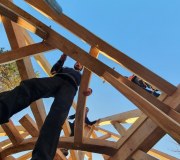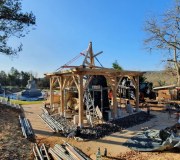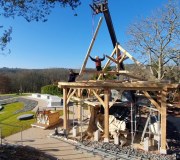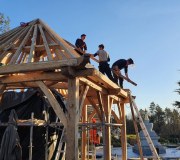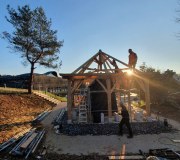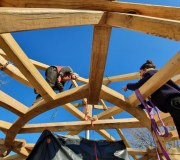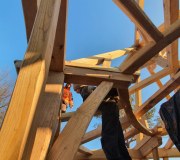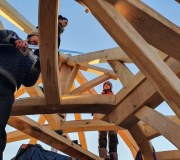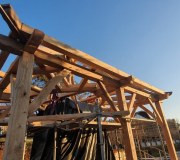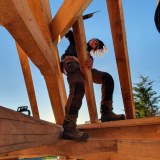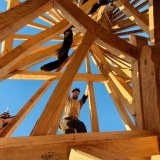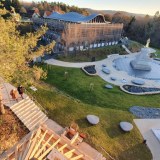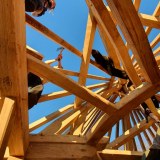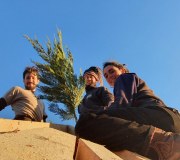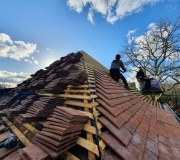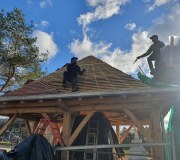The Wood Structure for the Prayer Wheel: Sacred Architecture and Traditional Carpentry

The Wood Structure for the Prayer Wheel: Sacred Architecture and Traditional Carpentry
Despite the less-than-pleasant winter weather, the artisans were able to complete the prayer wheel pavilion. Only the benches and the floor need to be finished.
A prayer wheel, especially one of this size, is no ordinary creation. Therefore, this place intended for meditation and wishing prayers required fitting surroundings. We called on the nearby collective Copeaux Cabana to help us. They are a group of artisans specializing in various types of work (carpentry, stone-cutting, decorative ironwork) who came together around the common value of traditional building methods in order to preserve and share their knowledge of vernacular architecture. Brunelle, Austin, et Yohann began by shaping the wood in their workshop. Then, they came to mount the final structure. Lastly, Matthieu, the roofer, put the last touch on—a roof of handmade terra cotta tiles.
We would like to share with you our meeting with a woman of wood: Brunelle, carpenter and the architect for this project.
![]() Click on the photos to enlarge
Click on the photos to enlarge
Dhagpo : Can you say a few words about the philosophy of your work?
Brunelle : We work in traditional carpentry. That means that the techniques themselves haven’t changed much from what carpenters did two hundred years ago. What has evolved somewhat are the tools we use, which are semi-modern and semi-traditional. What we do differs greatly from very modern wood construction with screws, etc. In terms of technique, we work with wood that has barely been treated. We retain the natural curves, and we follow the grain of the wood. We don’t have to make straight lines. That is the particularity of our wood structures; they can have curves, and that’s exactly what we’re looking for. Mechanically, it’s much more solid, and esthetically, it’s much more beautiful! As the individual pieces of wood are not all even, we use techniques like stitching with iron wire to deal with them. Furthermore, each joint is hand-traced. This is not the case in conventional carpentry with perfect, even timbers, where a protractor is employed. We can’t use a protractor. This is a technique specific to traditional carpentry.
Dhagpo: Do you have a particular philosophy concerning how forests are treated?
Brunelle: We would like to work with an ultra-local supply chain, from the forest management to the loggers to delivery to ourselves—for things to be close by and for there to be respect for the environment. Today, this has disappeared, and we have to rebuild the industry, which is complicated, so we do what we can.
For this project, the wood came from two different sites: one in Corrèze, and hour from here that practices sustainable forest-management with a qualitative approach. Unfortunately, they don’t produce enough for the amount we needed. Another part came from this region, twenty minutes from Dhagpo.
We’re exploring a third possibility, that of taking care of the forestry and logging ourselves, which would be ideal. However, this requires bringing together several crafts and professions. We’re working on creating this network.
Dhagpo: What is your specialty?
Brunelle: I specialize in sacred architecture. I learned symbolic geometry, working with a compass, etc. So, it’s been my dream to construct a building with a sacred vocation—regardless of the type of spirituality—because I feel that this is the pinnacle of what a space can allow. Thanks to shapes and proportions, it is possible to elevate the energy of a space, and that’s something I secretly cultivate. Each time I sketch a wood structure, I draw it with this awareness.
Dhagpo: How did you develop the structure for the prayer wheel?
Brunelle: On a concrete level, I started with the sides—the height and width that I needed to respect—and then, based on this, I tried to push the proportions as much as I could in the drawing. I found it interesting to start with a square base, which is very balanced. My work was to incorporate a circle into this base. The square often symbolizes earth, and the circle represents the cosmos. That’s why we suggested doing radiating beams (the flat carpentry above the wheel). Technically speaking, we could have done something simpler or with perpendicular timbers, but the idea of doing radiating was to creating a circle within the square. Because it is a prayer wheel that turns, this creates movement within the wood structure. The rafters, which are also radiant, are likewise intended to bring circular movement inside the square base. It was a lot harder to build, but for me it was a question of energy.
Another constraint I had to work with was created by the architects from Bâtiments de France [because Dhagpo is in a protected area], that the exterior of the pavilion had to be Perigordin in style. My wish was for the inner architecture to evoke Asia, where Buddhism originated. In Asia, constructions are erected via stacking. Instead of assembling elements on a single level, like we do in the West, in the East, layers are stacked on top of each other. We tried to preserve that in this structure—to create several layers to give a slightly more Asian touch.
Dhagpo: At the end, you nailed a branch of cedar to it…
Brunelle: It was the bouquet of seasonal flowers that gets nailed to the structure when it is finished. The tradition is to celebrate the completion of raising the frame. The roofer, who does his work after, cuts it, but he leaves the stem and the nail; that’s the tradition. Personally, it’s not so much the tradition that speaks to me but the idea of celebration, of ritualizing a moment of completion. It is a shared moment for everyone present. Raising a structure is always a beautiful moment. Since it’s still winter, a cedar branch replaced the flowers!
We will keep you informed of the advancement of construction. Don’t hestitate to sign up for Dhagpo’s newsletter to receive the latest news in words, photo, and video.


